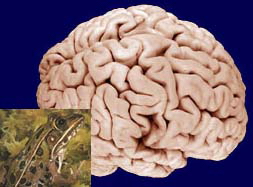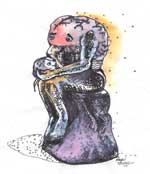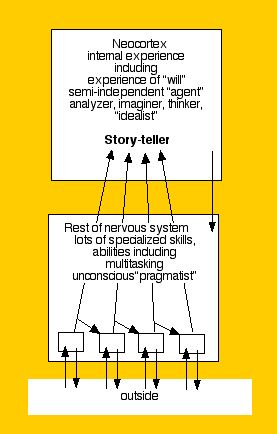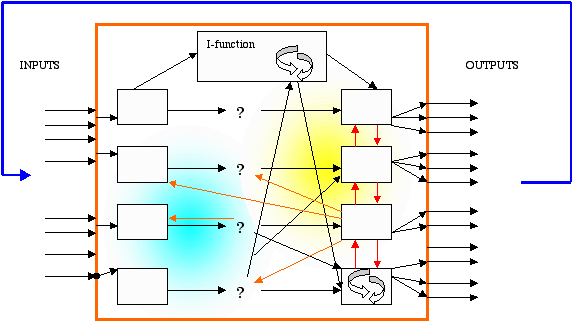Serendip is an independent site partnering with faculty at multiple colleges and universities around the world. Happy exploring!
BBI 2007 Session 15

 |
BRAIN AND BEHAVIOR INSTITUTE 2007 |

|
Generalized Control Mechanisms:
Mood, Emotion, Creativity, Self
Review and extension
Sensory experience is constructed, observations are themselves stories, best guesses based on ambiguous input which may have conflicting elements, require continual testing and revision

"As we get deeper into our study of the brain i am more convinced that we live in "The Matrix." As I remember "The Matrix" was a system that created what people needed to see and believe. We call these stories. The disturbing side to this is that once you were removed fom the "story/matrix" the world/reality was really crappy and bland." ... Deidre
"Think goodness our brain does fill in the holes and does not leave us in a state of ambiquity!" ... Judith
"I will teach my students that their brain has the ability to see the same thing in multiple ways." ... Tammi
"our students' brains may very well also be filling in the gaps based on a few observations they may make in class. We need- not only to do this ourselves- but also encourage our students to do the same- practice "getting it less wrong" by going back and editing and looking where our students' brains are spinning stories live, and encourage in our students the ability to self-check to make sure that we do indeed "get it less wrong" ... Graham
"I need to check more often and more carefully to see what it 'looks like' in their head. I know what I would like it to look like, at least most of the time. No matter how carefully I show, or arrange for students to do, concepts or skills their brains are only catching the edges and filling in the substance based on their own architecture" ... Bruce
"If we challenge the reality of our students with discrepant events will their search for their best reality cause new or more neurons to fire and thus a new or less wrong scenario to emerge?" ... Joyce
Blind sight - further evidence that the I-function/story teller is associated with neocortex (one can take in/use input without being aware of it)
The "crack" in the bipartite brain as a source of creativity, ability to conceive what hasn't been experienced
Generalized control mechanisms

- Mood, emotion important/valuable/bipartite, significant aspect of human diversity
- Creativity important/valuable/bipartite, particularly if science is as much conceiving what might be as revealing what is
- The story of the frog: "Intrinsic Variability"
- gambling
- trying things out
- interpersonal interaction, evolution

- Creativity with the I-function
- The story of the frog: "Intrinsic Variability"
- General states - pharmacology, semi-autonomy from environment/I-function
- Mood as additional observations/perspectives, a good thing (see "medical vs neurobiological model" of mental health; relevance to education?)
- Dreams as additional observations/perspectives
- Creativity as bipartite: unconscious and thoughtful
- Story telling as way of making sense of cacaophonous unconscious
- Feeling/emotion/intuition as important part of thinking
- Science as dependent on thinking/feeling/creating
- Impact of thinking/story telling on the unconscious
- Self as story



Comments
Emotions
Seeing is NOT believing!
Now I can argue that "Seeing is Not Believing." Why do I challenge this long held adage? Yesterday's presentation stated that the brain is always filling in missing information with our imaginations based on experiences because the "Input is always incomplete," "Input is always interpreted based on prior information," and "Input is always ambiguous." Again this proves that babies are true scientists because there must construct enormous amount of information before they start actually realizing the functionality of objects.
And today we learned that mood generation can be affected by I-function or develop independent of the I-function. What with our brains filling in missing sight information with our imagination and and moods being generated independently of the I-function. it is no wonder human brains need diverse feedback loops functioning constantly on all levels to keep our nervous system in a homeostasis state. I knew our nervous systems were extremely complicated and interactive but never to this extent. For lack of a $10 word, it is astounding!
Another point. Our talk has centered on the brain. Is not our minds different from our brains or are they one and the same?
And finally, today as we were discussing plasticity I tried to remember the following study done which I think vividly illustrates plasticity. (I think I have the facts correct.)
Nobel prize winners, David Hubel and Torsten Wiesel (had to confirm the names but knew they were Nobel Prize winners),covered 1 eye of newborn kittens. After 2 months, they took off the patches and found the eye that had been covered was effective blind. It was not connected to the brain despite the fact that the eye was perfectly normal from an optical point of view. The brain had no received stimulation from the eye and had rewired itself to receive information only from the other eye, the open eye. A sort of take over, all the brain cells in that portion of the brain had been taken over by 1 eye, leaving no connections to the other eye. I think this proves the brain can physically expand and contract depending on experience.
Emotions
emotions
Morning Response
reflection
W. Keith Sgrillo While
W. Keith Sgrillo While
W. Keith Sgrillo While
W. Keith Sgrillo While
emotions value
Mood Disorders
Post new comment